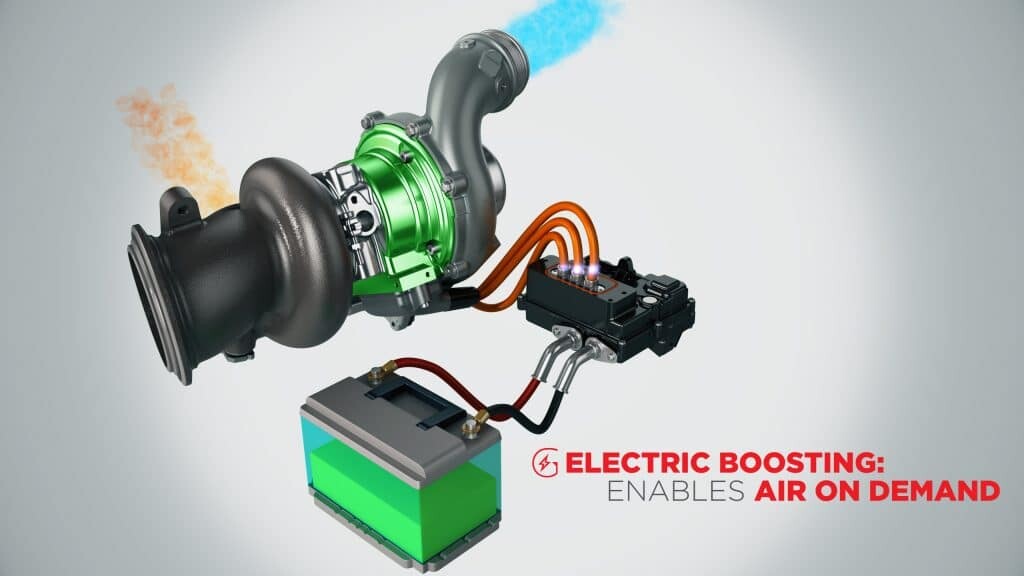Battery electric vehicles are on the rise, but the reality is that combustion engines are going to be around for a while ... and there's still room for improvement on the ICE front. Electricity is part of that equation too – namely electrified turbochargers, which promise a big step forward for efficiency and power delivery.
Turbos have proliferated into the automotive mainstream in recent times, improving power delivery and fuel economy as engines have become smaller and the quest for efficiency has ramped up. Now Garrett Motion, already well-established as a first tier component manufacturer and well-respected for its turbocharging technologies, has announced that it will be fielding electrified turbochargers (e-turbos) in 2021, with a particular focus on hybrid engines.
The e-turbo is an obvious next step for turbocharging in modern engines. The promise is that with more control over the turbocharger’s spooling, power (and thus efficiency) can be improved. To understand how that works, it’s important to know how turbochargers affect combustion to improve power output and efficiency in an engine.
A quick primer on turbocharging
An internal combustion engine ignites a fuel and air mixture in a chamber (cylinder) to create movement. Getting the fuel:air mixture right is crucial to getting the most power out of the least amount of fuel. Contrary to what we might think, power delivery is a big part of efficiency. If more power can be eked from less fuel, the engine is clearly more efficient. What those involved in motor racing learned long ago is that efficient power creation is better than fuel dumping for more muscle. The former creates better, more usable power and reduces weight, allowing the vehicle to go faster and maintain higher speeds for longer.
Turbochargers help improve the fuel:air mix in the engine by pushing more air into the combustion chamber under force, so the amount of air entering the chamber can be more precisely regulated. Non-turbocharged (aka “naturally aspirated”) engines draw air into the combustion chamber through the partial vacuum created by the retreating piston and opened intake valves. Supercharged engines use a forced air approach similar to turbochargers, but are driven by the engine itself, and so require power from the engine to operate. Although a supercharger is traditionally more controllable than is a turbocharger, it’s also more expensive and is not always as good for smaller displacement engines.
Conventional turbochargers are powered by the exhaust gasses from the engine, producing no drag to the engine’s power output. The exhaust spins a turbine which pulls in air, compressing it and pushing it into the intake for the cylinders. The downside to turbos is the lag (wait) in getting the engine from low pressure (low RPM) to high pressure (high RPM) in order to spin the turbocharger.
In a typical application, the turbocharger is sized to balance its turbine’s power delivery timing with engine needs. The larger the turbo compressor, the longer the lag before it kicks in to offer more power. Often this compromise means that the turbo is too small to operate efficiently at very high RPM. At high RPM rates, these turbos often shut down and more fuel is pumped into the engine to compensate and allow the turbo to cool down.
Companies like Volkswagen and Mercedes-Benz have developed two-stage turbochargers that use an electric motor to spin the turbo’s compressor until the exhaust gasses can catch up and take over at higher speeds. These dual-stage turbos are limited by the physics involved, as a small motor can only spin a compressor of a given size. Thus the aforementioned balance to size versus heat remains.

The E-Turbo
Garrett plans to take turbochargers to the level by going fully electric. The company's in-house E-Turbo design will soon be joined by competitors from other turbo makers like BorgWarner and Mitsubishi. Rather than having a compressor partially run by a smaller motor, the E-Turbo instead uses a larger electric motor to turn a larger compressor at lower speeds, eventually allowing the exhaust gasses to partially or fully turn the compressor as engine revs increase.
Essentially, the turbocharger can now be larger, which expands its usefulness for both power improvements and efficiency gains, while almost eliminating turbo lag. What’s more, the motor on the turbo can work in reverse.
When the turbo is no longer required, such as when slowing down or when the driver begins to “coast” at speed, the spinning turbo’s inertia can be captured and sent to the vehicle’s battery. Garrett has designed its E-Turbo specifically to work with the 48-volt systems now being used in many production vehicles. This captures energy that would otherwise just be sent out the exhaust pipe, further improving efficiency.
What’s more, the energy gained can then be used to once again spin up the turbo when demands are made by the throttle. Garrett says that these efficiency gains can mean up to 10 percent fuel efficiency improvement for a vehicle. Most will see somewhere in the 2-5 percent range, but it all depends on how the E-Turbo system is used and in what format. In addition, the E-Turbo can be used on a diesel engine for up to 20 percent NOx reduction, another big bonus.
Engines are shrinking, but power outputs aren’t, and Garrett believes the E-Turbo can help keep that trend going. Because the E-Turbo can use larger turbines, it can stay cooler during operation and thus won’t require the fuel dump smaller turbos must have to cool themselves during extended use.
Although several manufacturers are getting into the e-turbo game, only Garrett has announced its planned use in an upcoming vehicle. What vehicle, we don’t know, but we are told it’s a large-scale manufacturer and it will be a production model, not an experiment. Our best guess is Jaguar Land Rover, as the two companies have cooperated on similar tech before.
When it comes, the E-Turbo could revolutionize engine efficiency and translate to big improvements for the industry in the near-term.
Source: Garrett Motion





